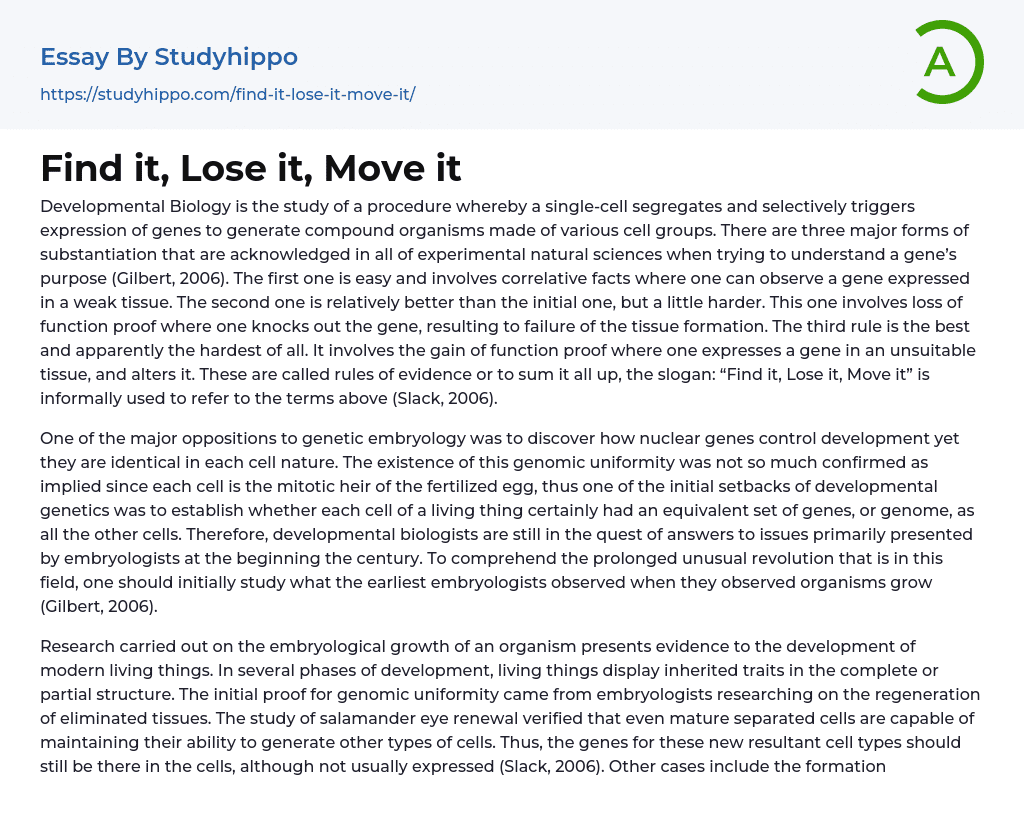Developmental Biology is the study of a procedure whereby a single-cell segregates and selectively triggers expression of genes to generate compound organisms made of various cell groups. There are three major forms of substantiation that are acknowledged in all of experimental natural sciences when trying to understand a gene’s purpose (Gilbert, 2006). The first one is easy and involves correlative facts where one can observe a gene expressed in a weak tissue. The second one is relatively better than the initial one, but a little harder. This one involves loss of function proof where one knocks out the gene, resulting to failure of the tissue formation. The third rule is the best and apparently the hardest of all. It involves the gain of function proof where one expresses a gene in an unsuitable tissue, and alters
...it. These are called rules of evidence or to sum it all up, the slogan: “Find it, Lose it, Move it” is informally used to refer to the terms above (Slack, 2006).
One of the major oppositions to genetic embryology was to discover how nuclear genes control development yet they are identical in each cell nature. The existence of this genomic uniformity was not so much confirmed as implied since each cell is the mitotic heir of the fertilized egg, thus one of the initial setbacks of developmental genetics was to establish whether each cell of a living thing certainly had an equivalent set of genes, or genome, as all the other cells. Therefore, developmental biologists are still in the quest of answers to issues primarily presented by embryologists at the beginning the century. To comprehend the prolonged unusual
revolution that is in this field, one should initially study what the earliest embryologists observed when they observed organisms grow (Gilbert, 2006).
Research carried out on the embryological growth of an organism presents evidence to the development of modern living things. In several phases of development, living things display inherited traits in the complete or partial structure. The initial proof for genomic uniformity came from embryologists researching on the regeneration of eliminated tissues. The study of salamander eye renewal verified that even mature separated cells are capable of maintaining their ability to generate other types of cells. Thus, the genes for these new resultant cell types should still be there in the cells, although not usually expressed (Slack, 2006). Other cases include the formation and loss of hair throughout the human growth; creation and disintegration of a yolk sac; emergence of gill-like formations in vertebrate embryo growth, among others.
- Microbiology essays
- Bacteria essays
- Cell essays
- Enzyme essays
- Photosynthesis essays
- Plant essays
- Natural Selection essays
- Protein essays
- Viruses essays
- Cell Membrane essays
- Human essays
- Stem Cell essays
- Breeding essays
- Biotechnology essays
- Cystic Fibrosis essays
- Tree essays
- Seed essays
- Coronavirus essays
- Zika Virus essays
- Pregnancy essays
- Death essays
- Asthma essays
- Chronic Pain essays
- Diabetes essays
- Infection essays
- Infertility essays
- Pain essays
- Sexually Transmitted Disease essays
- Cholesterol essays
- Epidemic essays
- Pathogen essays
- Symptom essays
- Water supply essays
- Myocardial Infarction essays
- Chronic essays
- Hypertension essays
- Black Death essays
- Breast Cancer essays
- Down Syndrome essays
- Apoptosis essays
- Tuskegee Syphilis Experiment essays
- Type 2 Diabetes essays
- Agriculture essays
- Albert einstein essays
- Animals essays
- Archaeology essays
- Bear essays
- Biology essays
- Birds essays
- Butterfly essays




